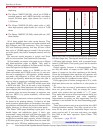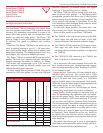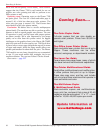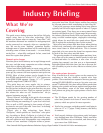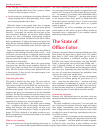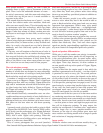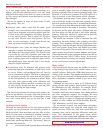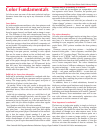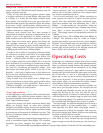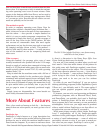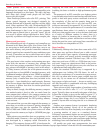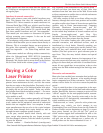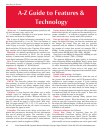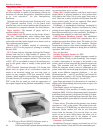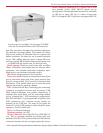
62
Entire Contents © 2006 Prog
ressiv
e Business Pub
lications
.
Copying of Pages Prohibited.To Order: 800 247 2185 or www.betterbuys.com
example 600 x 600dpi (which we call 600dpi for short)
means a grid with 360,000 individual elements that the
p
rinter can place toner on.
Today, all color and black-only printers produce pages
at a native resolution of at least 600dpi, and some work
at 1,200dpi. It is widely felt that higher numbers mean
better quality. And whether or not you agree with this, it
seems inevitable that the dpi resolution figure will always
be the most “visible” specification by which printers are
judged on paper because it attempts to boil down several
complex elements to a single value.
However, most vendors have their own versions of
interpolated resolutions, meaning a manipulation of the
output to give it the appearance of higher resolution.
Some vendors seem to have better software for this than
others. Some have better toner quality that allows for
finer apparent resolution. It’s all very confusing. For
example, HP has come up with a heavily patented tech-
nology called ImageREt 2400 that supposedly delivers
2,400dpi-grade results from a 600dpi engine.
Caught in the crossfir
e of
competing technical claims,
the conclusion we draw is that there is no single magic
formula for designing color printers that deliver fine
results — different paths can lead to the same destina-
tion.
A higher r
esolution can be helpful, but it is not the
be-all and end-all of everything. In commercial printing,
for example, resolution is considered more important for
te
xt than for reproducing photographic images. And
don’t forget that image quality can be in the eye of the
beholder — that’s why it makes sense to look before you
buy. In an
y case, all the products on the market now seem
to deli
ver adequate business color.
Keep in mind that a few models with 1,200dpi maxi-
m
um r
esolutions may extract hefty speed penalties when
you take advantage of their capabilities. Hence, even if
1,200dpi is available, you might choose to print most of
your work at 600dpi on some printers.
“True” high resolution
As indica
ted a
bove, many printers offer resolutions high-
er than 600dpi. But within the printer industry, there are
occasional squa
b
b
les a
bout w
ha
t can r
eall
y be consider
ed
“true” high-resolution output.
Some laser printers that boast resolutions higher than
600dpi ar
e actuall
y based on what were originally
designed to be 600dpi engines
, but they use software that
causes the laser beam to create a higher-resolution image
by placing tens of thousands of additional tiny dots. This
process is sometimes known as “software interpolation”
or “modulation.”
Most ne
wer engines are designed from the ground up to
work at resolutions higher than 600dpi. The technical
arguments g
et pr
etty comple
x,
b
ut purists insist tha
t
“from the ground up” means “better.” The phrases
“native resolution” and “true resolution” are sometimes
used to refer to the base resolution of an engine before
any software modulation kicks in.
As we’ve said previously, true 1,200dpi resolution on
some printers can result in a big hit on some printers’
speeds. Note that modulated higher resolutions some-
times have numbers that read something like “1,200 x
600dpi” — in other words, the “dot intensity” along one
axis is greater than along the other. Vendors often use the
term “class” to mean interpolation, as in “2,400dpi
class.” That simply means an interpolated resolution of
2,400dpi.
How much does 1,200 x 600dpi differ from 600dpi or
1,200dpi? The difference may be visible in complex
graphics and smaller type sizes, but only with a magnify-
ing glass. Your salesman may tout these figures, but they
are less important than the actual appearance of the
printed page and the quality of the imaging system and
toner, which can’t be measured in numbers.
Operating Costs
Operating cost comparisons can be quite tricky to make
in the color printer mar
ket. In the monoc
hrome market,
ther
e’
s a consensus among vendors that quoted consum-
ables figures are based on an assumption of the image
area co
vering 5 percent of a page (which is more than it
sounds when you think about the white space in the mid-
dle of
letters lik
e “e” and “o”).
Although that 5 percent
figure ma
y or may not be an accurate representation of
what occurs in practice, it does provide a constant stan-
dard against which you can make like-for-like compar-
isons between different monochrome machines.
In the color market, however, numerous variables can
enter into a cost-per-page analysis. For example, the cost
of
a printed pa
ge depends not only on the size of the
image area but also on the color mix and the type of
image being printed. A number of vendors have come up
with their idea of the standard page on which they base
their cost-per-page figures. The problem, however, is that
the standar
ds ma
y be dif
ferent from vendor to vendor.
Not surprisingly, the different standards tend to show a
particular vendor in its best possible light — a vendor
with especially low black toner costs might assume a
higher proportion of black, for example. And some ven-
dor
s quote cost-per
-page figures without even explaining
the basis on which they are reached.
Putting aside the issue of vendor self-interest, a recent
color stud
y b
y Xer
o
x sho
w
ed tha
t the average business
page coverage is more like 4 percent per color than 5 per-
Better Buys for Business



